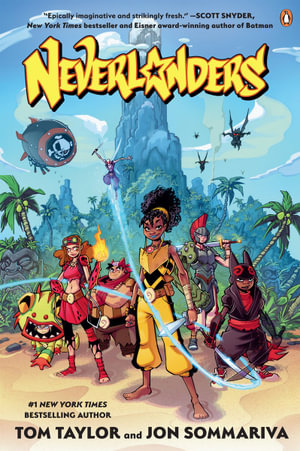Neverlanders by Tom Taylor and Jon Sommariva

Young, girls, Bee and Luz, are seen begging in a subway station, the girls are confident and colourfully dressed while the commuters are grey and uninterested. When Luz is accidentally pushed onto the tracks and injured no one wants to help so Bee jumps down to rescue her and they are pulled to safety at the last minute by Paco, a homeless boy. Paco is invited to join the homeless gang if he agrees to the rules, share everything, no strangers and no lies. They have weapons but no guns since experiencing school shootings. But Paco is caught talking to someone that night. That person turns out to be Tinkerbell but this foul mouthed aggressive sprite is a far cry from the original Peter Pan fairy. They offer the group a better life and whisk them away to Neverland. Neverland is also different from the magical land of Peter Pan, but it is “a place where people from the world who have hurt us or let us down aren’t welcome”. The magical island is under attack from Otherland, the land of adults, "yesterday’s people”, a place of “something dirty and dark”. While Otherlanders cannot enter Neverland, they can send goblins and other evil creatures to attack the children and steal parts of the magical healing tree. Thrown into battle, the children wonder if they have made the right decision but then they are able to choose magical costumes which give them superpowers and all except their leader, Justin, embrace their new world. Jason is shot in the battle, then healed by the magical tree but he is feeling lost and angry and this turns to resentment and discontent which does not bode well for the future.
Tom Taylor and Jon Sommavara have taken the concept of the Peter Pan story and reimagined it for the modern world. The stylish, brilliantly coloured graphics and imaginative framing catapult the action from intensely detailed, full page images to a rush of inset, angled and creatively divided frames, maintaining the fast pace of this dense narrative. There are no wasted frames and the characters are engaging, consistent and develop. This very modern story reflects on some important themes like responsibility for the planet and each other. The selfish adults have refused to take responsibility for their actions and it is up to the next generation to turn that around. However, the children’s superpowers come from happy thoughts and this makes for a fun, quirky, not too serious tone throughout. The ending is rather complicated but sets the story up to be continued as is suggested in a great publisher’s interview with the author and illustrator. There are also comprehensive teachers notes.
Themes: Fantasy, Comics, Graphic retelling, Pirates, Found family, Adventure, Friendship.
Sue Speck